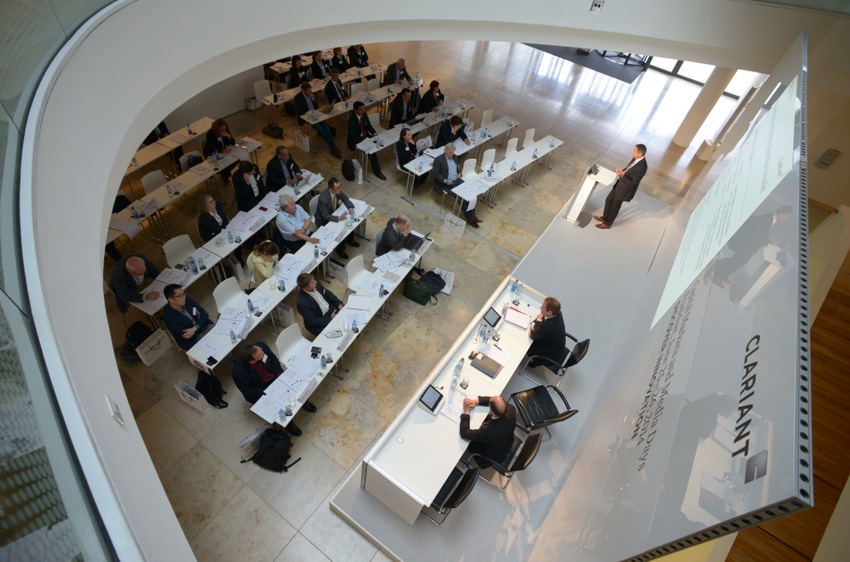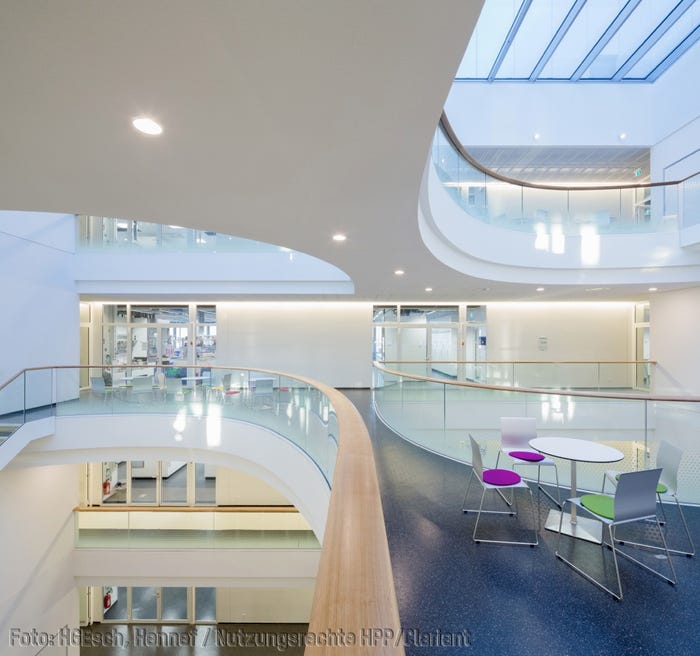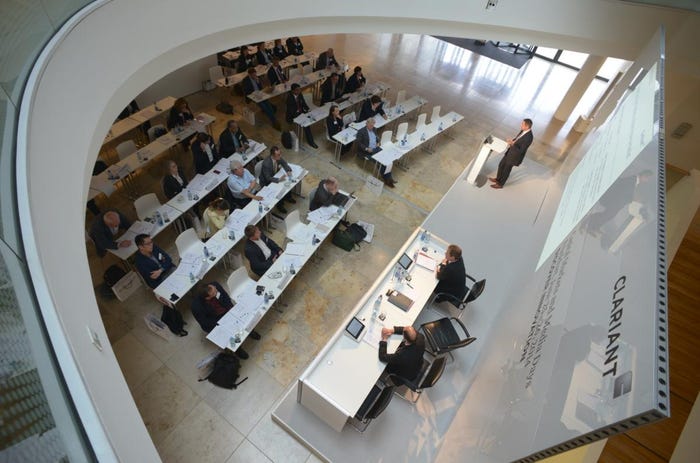Frankfurt, Germany — 'Discover Innovation' was the theme of Clariant's Media Day event held on June 25-26 at the company's brand spanking new Innovation Center in Frankfurt. The new CIC features a light, open workplace design to foster contact and communication while providing state-of-the-art chemical research laboratory facilities for the approximately 500 employees who work here.
June 26, 2014

Frankfurt, Germany — 'Discover Innovation' was the theme of Clariant's Media Day event held on June 25-26 at the company's brand spanking new Innovation Center in Frankfurt. The new CIC features a light, open workplace design to foster contact and communication while providing state-of-the-art chemical research laboratory facilities for the approximately 500 employees who work here. The new facilities have also enabled R&D to be centralized at a single location instead of dispersed across various sites: "A far better way of organizing these activities," said Clariant CEO Hariolf Kottmann.
 The Media Day event opened with a presentation from Kottmann, who was visibly pleased to announce that the company's focus on profitable growth was starting to deliver. "The repositioning of the portfolio, which we started in 2009, has resulted in a doubling of our profitability," he said. "We divested five businesses and acquired Süd-Chemie, a specialty chemical company headquartered in Munich. Today, we are focused on markets with future perspectives and strong growth rates, and businesses with competitive positions and significant pricing power."
The Media Day event opened with a presentation from Kottmann, who was visibly pleased to announce that the company's focus on profitable growth was starting to deliver. "The repositioning of the portfolio, which we started in 2009, has resulted in a doubling of our profitability," he said. "We divested five businesses and acquired Süd-Chemie, a specialty chemical company headquartered in Munich. Today, we are focused on markets with future perspectives and strong growth rates, and businesses with competitive positions and significant pricing power."
"It's now time to take the Clariant story to the next level," he added. "Performance, growth and innovation, driven by global trends and challenges is key to closing the gap between our profitability level of 14.1 percent today and the 16-19 percent EBIDTA margin we wish to achieve in 2015 and beyond."
CFO Patrick Jany then outlined Clariant's strategy of cost efficiency on the one hand, and growth on the other, by which the company aims to achieve this goal. He noted the priority on cash generation - "we sell businesses if we have no competitive advantages" - but emphasized that "sustainable long-term value creation is based on innovation and growth," a theme that almost all the speakers returned to in their presentations throughout the day.
Clariant devoted very considerable resources - some 3.3% of group sales - to innovation in 2013.
According to member of the executive committee Christian Kohlpaintner, innovation at Clariant is heavily market and customer oriented. "We aim for a profound understanding of market and customer needs," he said. That makes the real difference. It's an outside-in approach: we don't invent things and then look for the customers. Innovation is discovering value and meeting unmet needs, and converting these via structured processes into products and solutions."
The company's resource allocation to innovation reflects a focus on attractive market segments that are driven by megatrends, such as functional packaging, biobased chemicals, shale oil and gas, or nutrition and heath. Kohlpaintner and Chief Technology Officer Martin Vollmer detailed some of the on-the-ground investments, strong cross-business synergies, a dedicated ideas-to-market process, and Clariant's approach to creative exchange, which together prioritize investment areas and support the creation of added-value innovations for customers and markets.
"We have R&D centers across the globe," said Kohlpaintner. "They foster a non-Eurocentric view."
Hans Bohnen, head of the masterbatches business unit at Clariant, discussed the latest masterbatch solutions in the innovation pipeline. "Clariant Masterbatches has repositioned itself as a more innovation-driven business," he commented. "On the back of cost measures and improved performance, a stong record in profitability has been built."
Important developments are CESA-absorb for active oxygen barriers in PET packaging and advanced Hydrocerol nucleating agents for new-generation construction insulation.
CESA-absorb is a novel masterbatch with an integrated active oxygen barrier that optimally protects sensitive packaged goods from oxygen-induced degradation. It provides superior and long-term oxygen barrier performance to PET packaging such as bottles and films without impacting on transparency or the recyclability of PET. Based on proprietary and patent protected Clariant chemistries, the oxygen scavenging units consist of a catalyst and an oxidizable substrate, which are uniformly dispersed in the polymeric matrix of the packaging wall.
Clariant has developed Hydrocerol nucleating solutions for insulation materials that will address the gap in the construction market for effective, energy-reduction insulation materials within thinner, space-saving boards. Existing buildings are responsible for almost 40% of global CO2 emissions, while valuable space is lost through thick insulation panels used in today's constructions.
Clariant's Hydrocerol-based masterbatches enable foaming of lightweight polystyrene at significantly smaller size than the currently known foams. The newly designed formulation enables, in the presence of direct gassing, a cell size reduction from 200 to 50 μm. In addition, the optimized foam structure has excellent insulation properties. As a result, manufacturers will be able to produce strong and light insulation boards with improved insulation that also enable maximum living space, and contribute to saving material use and production costs. They also support the fulfilment of energy saving regulations.
CESA-absorb and the advanced Hydrocerol nucleating solutions are scheduled for commercial launch at the end of 2014/beginning 2015, respectively.
Asked about other projects in the longer term, Bohnen said that there were three masterbatch breakthroughs expected within 0-2 years, one being the CESA-absorb development. "Two other areas are recyclability: when plastics are recycled, there's often an odor that clings. We're studying how to rid of that odor. Another development is 'easy to empty' packaging. So much waste is caused by the fact that up to 20% of a product gets left behind in the packaging when it is thrown away. We are developing a solution based on a different surface structure, to adress this problem."
"These are basic, chemical developments that are really new," he added. "But as always, with a focus on what the customer wants and needs."
About the Author(s)
You May Also Like


